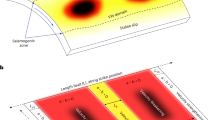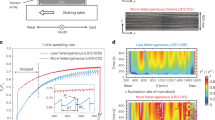Abstract
THEORETICAL and experimentally based laws for seismic faulting contain a critical slip distance1–5, Dc, which is the slip over which strength breaks down during earthquake nucleation. On an earthquake-generating fault, this distance plays a key role in determining the rupture nucleation dimension6, the amount of premonitory and post-seismic slip7–10, and the maximum seismic ground acceleration1,11. In laboratory friction experiments, D
c has been related to the size of surface contact junctions2,5,12; thus, the discrepancy between laboratory measurements of Dc (∼10−5m) and values obtained from modelling earthquakes (∼10−2m) has been attributed to differences in roughness between laboratory surfaces and natural faults5. This interpretation predicts a dependence of Dc on the particle size of fault gouge2 (breccia and wear material) but not on shear strain. Here we present experimental results showing that Dc scales with shear strain in simulated fault gouge. Our data suggest a new physical interpretation for the critical slip distance, in which Dc is controlled by the thickness of the zone of localized shear strain. As gouge zones of mature faults are commonly 102–103 m thick12–17, whereas laboratory gouge layers are 1–10 mm thick, our data offer an alternative interpretation of the discrepancy between laboratory and field-based estimates of Dc.
This is a preview of subscription content, access via your institution
Access options
Subscribe to this journal
Receive 51 print issues and online access
$199.00 per year
only $3.90 per issue
Buy this article
- Purchase on Springer Link
- Instant access to full article PDF
Prices may be subject to local taxes which are calculated during checkout
Similar content being viewed by others
References
Ida, Y. J. geophys. Res. 77, 3796–3805 (1972); Bull. seism. Soc. Am. 63, 959–968 (1973).
Dieterich, J. H. J. geophys. Res. 84, 2161–2168 (1979); in Mechanical Behaviour of Crustal Rocks, Geophys. Monogr. Ser. Vol. 24 (eds Carter, N. L., Friedman, M., Logan, J. M. & Sterns, D. W.) 103–120 (Am. Geophys. Un., Washington DC, 1981).
Ruina, J. geophys. Res. 88, 10359–10370 (1983).
Andrews, D. J. Bull. seism. Soc. Am. 75, 1–21 (1985).
Scholz, C. H. Nature 336, 761–763 (1988).
Dieterich, J. H. in Earthquake Source Mechanics (eds. Das, S., Boatwright, J. & Scholz, C.) 37–47 (Am. Geophys. Un., Washington DC, 1986); Tectonophysics 211, 115–134 (1992).
Tse, S. T. & Rice, J. R. J. geophys. Res. 91, 9452–9472 (1986).
Lorenzetti, E. & Tullis, T. E. J. geophys. Res. 94, 12,343–12,361, (1989).
Marone, C., Scholz, C. H. & Bilham, R. J. geophys. Res. 96, 8441–8452 (1991).
Stuart, W. D. Pure appl. Geophys. 126, 619–641 (1988).
Aki, K. J. geophys. Res. 84, 6140–6148 (1979); 92, 1349–1355 (1987).
Rabinowicz, E. J. J. appl. Phys. 22, 1373–1379 (1951); 27, 131–135 (1956).
Feng, R. & McEvilly, T. V. Bull. seism. Soc. Am. 73, 1701–1720 (1983).
Scholz, C. H. Geology 15, 493–497 (1987).
Chester, F. M., Evans, J. P. & Biegel, R. L. J. geophys. Res. 98, 771–786 (1993).
Michelini, A. & McEvilly, T. V. Bull. seism. Soc. Am. 81, 524–552 (1991).
Montgomery, D. R. & Jones, D. L. Geology 20, 55–58 (1992).
Linker, M. F. & Dieterich, J. H. J. geophys. Res. 97, 4923–4940 (1992).
Marone, C. Raleigh, C. B. & Scholz, C. H. J. geophys. Res. 95, 7007–7025 (1990).
Biegel, R. L., Sammis, C. G. & Dieterich, J. H. J. struct. Geol. 11, 827–846 (1989).
Marone, C. & Cox, S. J. D. Eos 71, 457 (1991).
Mühlaus, H.-B. & Vardoulakis, I. Géotechnique 37, 271–283 (1987).
Jaeger, H. M. & Nagel, S. R. Science 255, 1523–1532 (1992).
Lambe, T. W. & Whitman, R. V. Soil Mechanics (Wiley, New York. 1969).
Boitnott, G. N., Biegel, R. L., Scholz, C. H., Yoshioka, N. & Wang, W. J. geophys. Res. 97, 8965–8978 (1992).
Marone, C. & Scholz, C. H. J. struct. Geol. 11, 799–814 (1989).
Power, W. L. & Tullis, T. E. J. geophys. Res. 97, 15425–15435 (1992).
Sibson, R. H. Nature 316, 248–251 (1985); Pure appl. Geophys. 124, 159–176 (1986).
Rice, J. R. J. geophys. Res. (in the press)
Wong, T.-F. & Zhao, Y. Tectonophysics 175, 177–195 (1990).
Scott, D. R., Marone, C. & Sammis, C. J. geophys. Res. (submitted).
Author information
Authors and Affiliations
Rights and permissions
About this article
Cite this article
Marone, C., Kilgore, B. Scaling of the critical slip distance for seismic faulting with shear strain in fault zones. Nature 362, 618–621 (1993). https://doi.org/10.1038/362618a0
Received:
Accepted:
Issue Date:
DOI: https://doi.org/10.1038/362618a0
This article is cited by
-
Cyclic shear behavior of dredged soil under constant normal stress conditions
Environmental Earth Sciences (2024)
-
Distinct element modelling of mining-induced instability of a heterogeneous fault
Bulletin of Engineering Geology and the Environment (2023)
-
Numerical modelling of spatially and temporally distributed on-fault induced seismicity: implication for seismic hazards
International Journal of Coal Science & Technology (2023)
-
Creep fronts and complexity in laboratory earthquake sequences illuminate delayed earthquake triggering
Nature Communications (2022)
-
Intermittent lab earthquakes in dynamically weakening fault gouge
Nature (2022)
Comments
By submitting a comment you agree to abide by our Terms and Community Guidelines. If you find something abusive or that does not comply with our terms or guidelines please flag it as inappropriate.



